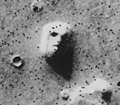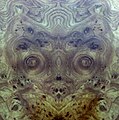Pareidolia
The term pareidolia (Template:Pron-en) describes a psychological phenomenon involving a vague and random stimulus (often an image or sound) being perceived as significant. Common examples include seeing images of animals or faces in clouds, the man in the moon, and hearing hidden messages on records played in reverse. The word comes from the Greek para- —"beside", "with" or "alongside"- meaning, in this context, something faulty or wrong (as in paraphasia, disordered speech)—and eidolon—"image" (the diminutive of eidos—"image", "form", "shape"). Pareidolia is a type of apophenia.
Examples
Religious
There have been many instances of perceptions of religious imagery and themes, especially the faces of religious figures, in ordinary phenomena. Many involve images of Jesus, the Virgin Mary, or the word Allah.
In 1978, a New Mexican woman found that the burn marks on a tortilla she had made appeared similar to the traditional western depiction of Jesus Christ's face. Thousands of people came to see the framed tortilla.[1]
The recent publicity surrounding sightings of religious figures and other surprising images in ordinary objects, combined with the growing popularity of online auctions, has spawned a market for such items on eBay. One famous instance was a grilled cheese sandwich with the Virgin Mary's face.[2]
In September, 2007, the so-called "monkey tree phenomenon" caused a minor social mania in Singapore. A callus on a tree there resembles a monkey, and believers have flocked to the tree to pay homage to the Monkey God.[3]
Scientific
From the late 1970s through the early 1980s, Japanese researcher Chonosuke Okamura self-published a famous series of reports titled "Original Report of the Okamura Fossil Laboratory" in which he described tiny inclusions in polished limestone from the Silurian period (425 mya) as being preserved fossil remains of tiny humans, gorillas, dogs, dragons, dinosaurs, and other organisms, all of them only millimeters long, leading him to claim "There have been no changes in the bodies of mankind since the Silurian period . . . except for a growth in stature from 3.5 mm to 1,700 mm."[4]
Rorschach inkblot test
The Rorschach inkblot test uses pareidolia in an attempt to gain insight into a person's mental state. The Rorschach is a projective test, as it intentionally elicits the thoughts or feelings of respondent which are `projected' onto the ambiguous inkblot images. Projection in this instance is a form of "directed pareidolia" because the cards have been deliberately designed not to resemble anything in particular. [1]
Audio
In 1971, Konstantin Raudive wrote Breakthrough, detailing what he believed was the discovery of electronic voice phenomenon (EVP). EVP has been described as auditory pareidolia.[1]
The allegations of backmasking in popular music have also been described as pareidolia.[1]
Explanations
Carl Sagan hypothesized that as a survival technique, human beings are "hard-wired" from birth to identify the human face. This allows people to use only minimal details to recognize faces from a distance and in poor visibility but can also lead them to interpret random images or patterns of light and shade as being faces.[5]
A 2009 magnetoencephalography study found that objects incidentally perceived as faces evoke an early (165 ms) activation in the ventral fusiform cortex, at a time and location similar to that evoked by faces, whereas other common objects do not evoke such activation. This activation is similar to a slightly earlier peak at 130 ms seen for images of real faces. The authors suggest that face perception evoked by face-like objects is a relatively early process, and not a late cognitive reinterpretation phenomenon.[6]
Gallery
-
This alarm clock appears to have a sad face.
-
A satellite photo of a Mars mesa, with shadows creating the famous Face on Mars
-
False wood
-
Mature ivy suggests a person clinging to the tree
See also
- Apophenia
- Clustering illusion
- Face perception, for the cognitive process
- Fooled by Randomness
- Ghosts as an artifact of pareidolia
- Images of Jesus
- Paranoiac-critical method
- Perceptions of religious imagery in natural phenomena
- Simulacrum
- Other natural examples
- Badlands Guardian
- Cydonia (the "Face on Mars")
- Man in the Moon
- Manicouagan Reservoir
- Moon rabbit
- Old Man of the Mountain
- Sleeping Giant (Ontario)
References
- ^ a b c d Zusne, Leonard (1989). Anomalistic Psychology: A Study of Magical Thinking. Lawrence Erlbaum Associates. pp. 77–79. ISBN 0805805087. Retrieved 2007-04-06.
{{cite book}}: Unknown parameter|coauthors=ignored (|author=suggested) (help) - ^ "'Virgin Mary' toast fetches $28,000". BBC News. 23 November 2004. Retrieved 2006-10-27.
{{cite news}}: Check date values in:|date=(help) - ^ Ng Hui Hui (13 September 2007). "Monkey See, Monkey Do?". The New Paper. p. 12, 13.
{{cite news}}: Check date values in:|date=(help); Italic or bold markup not allowed in:|publisher=(help) - ^ [1] Spamer, E. "Chonosuke Okamura, Visionary"
- ^ Sagan, Carl (1995). The Demon-Haunted World - Science as a Candle in the Dark. New York: Random House. ISBN 0-394-53512-X.
- ^ Hadjikhani N, Kveraga K, Naik P, Ahlfors SP (2009). "Early (M170) activation of face-specific cortex by face-like objects". Neuroreport. doi:10.1097/WNR.0b013e328325a8e1. PMID 19218867.
{{cite journal}}: Unknown parameter|month=ignored (help)CS1 maint: multiple names: authors list (link)
External links
- Fortean Times examples of pareidolia in nature
- Religious Pareidolia extensive collection of video and photographic demonstrations of pareidolia
- Skepdic.com Skeptic's Dictionary definition of pareidolia
- Lenin in my shower curtain (Bad Astronomy)
- The Stone Face: Fragments of An Earlier World
- Feb. 13, 2007, article in The New York Times about cognitive science of face recognition
- Cells in temporal cortex of conscious sheep can respond preferentially to the sight of faces. Science. 1987 Apr 24;236(4800):448-50.
- Invariant visual representation by single neurons in the human brain. Nature. 2005 Jun 23;435(7045):1102-7.




